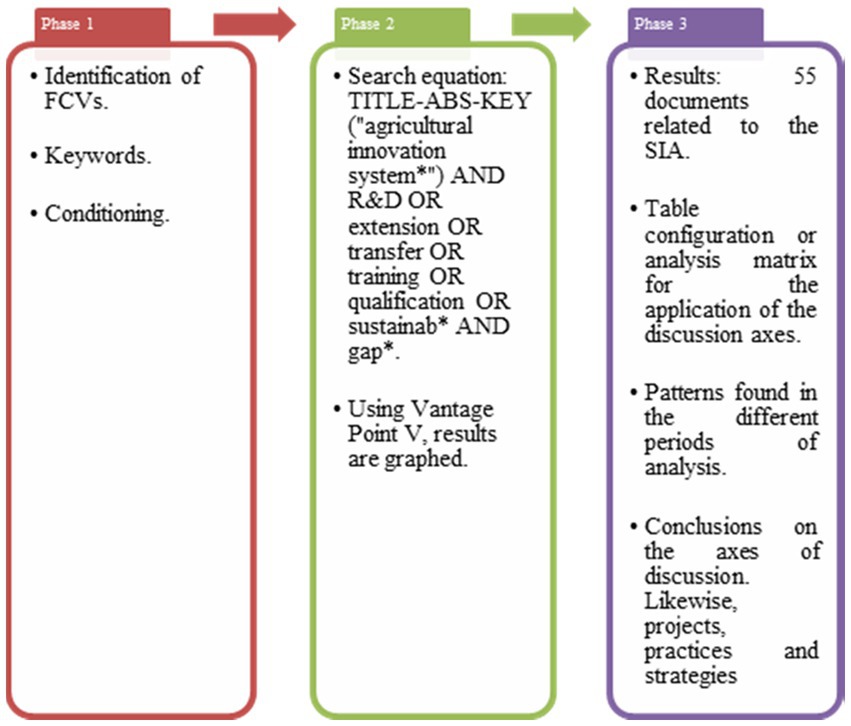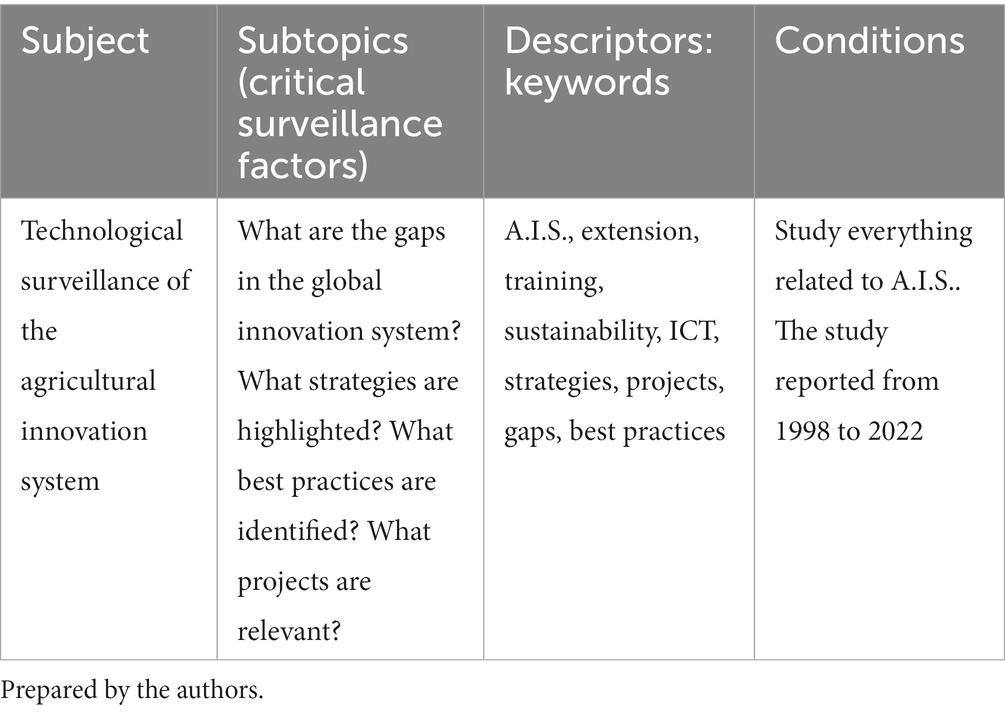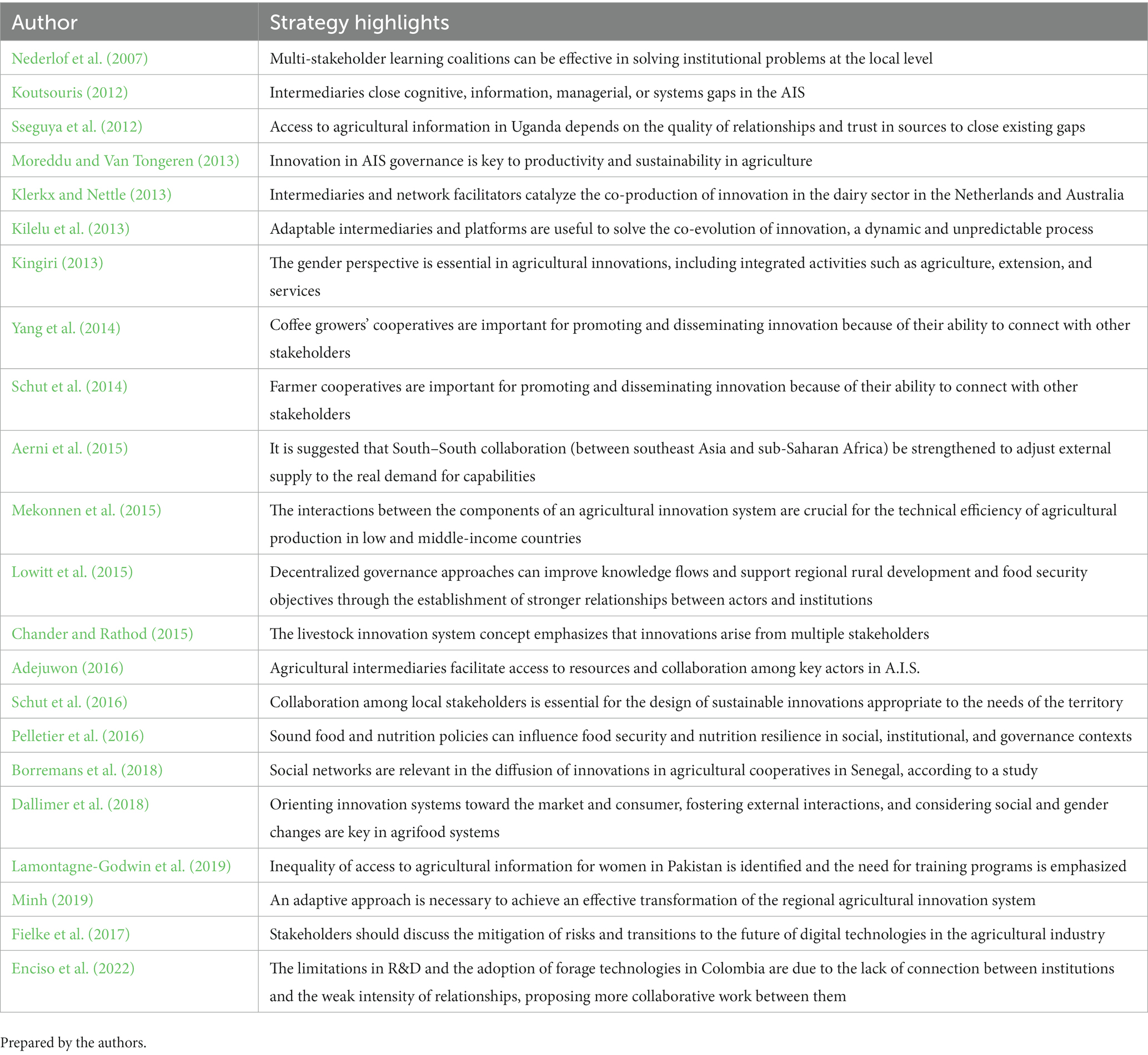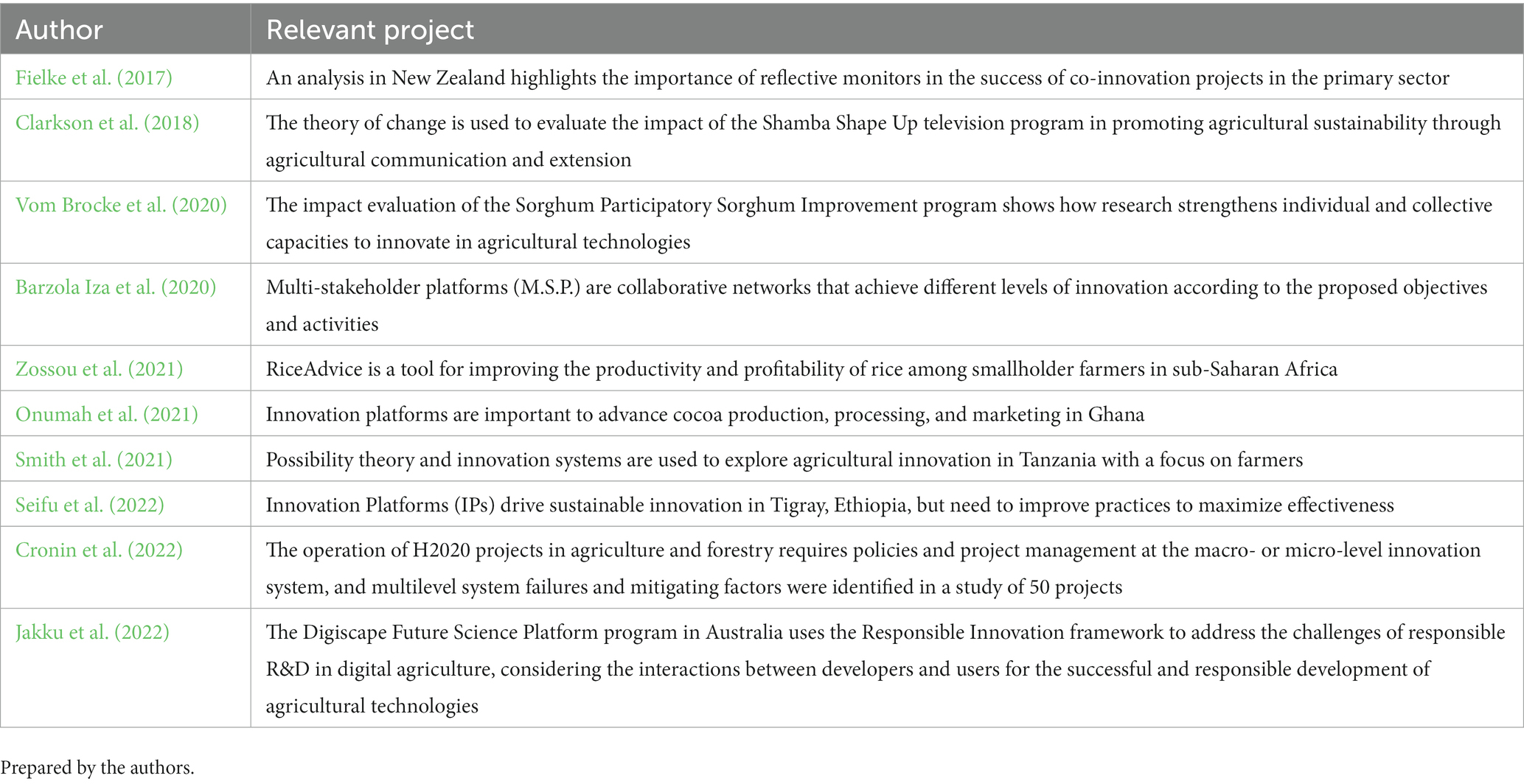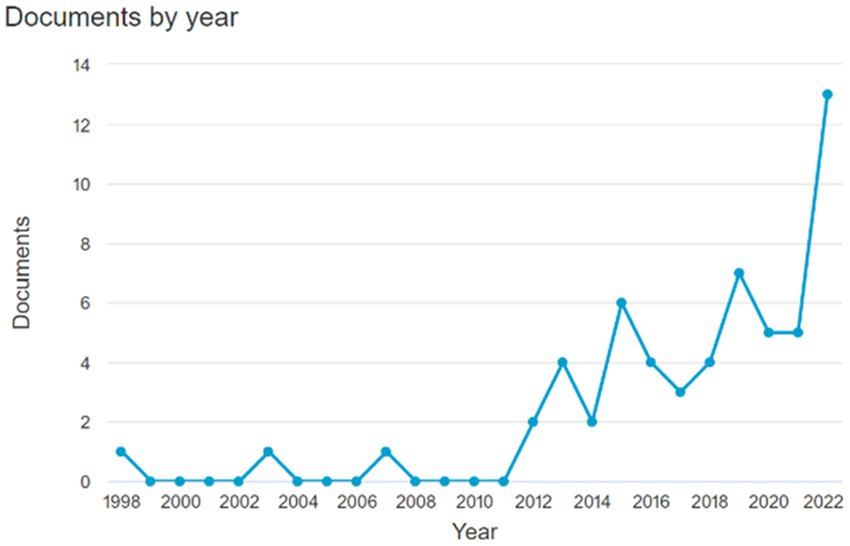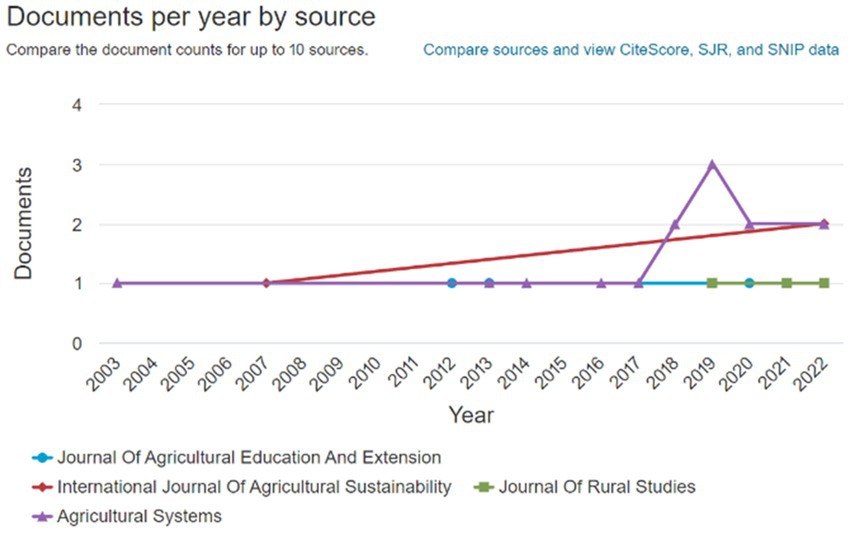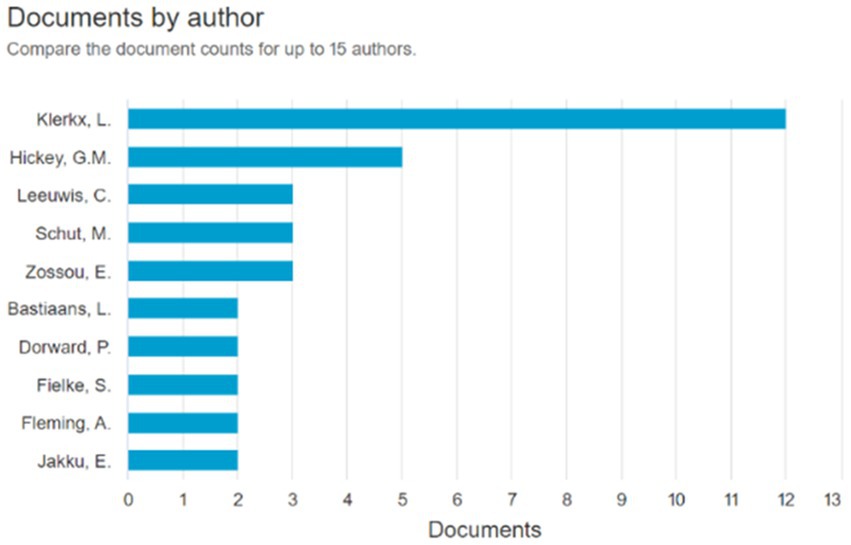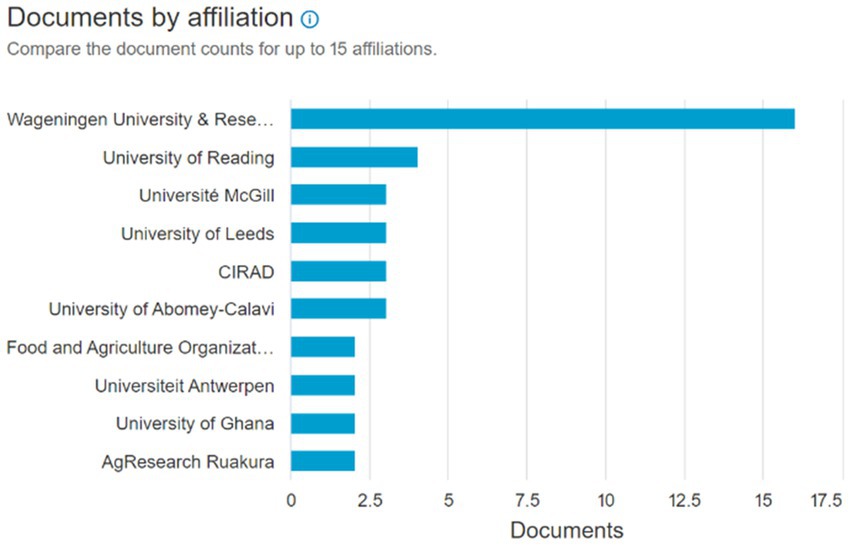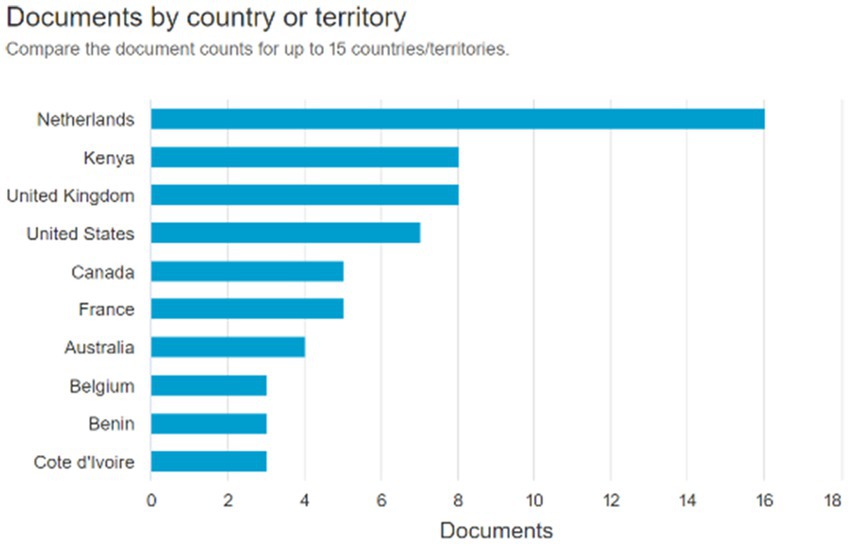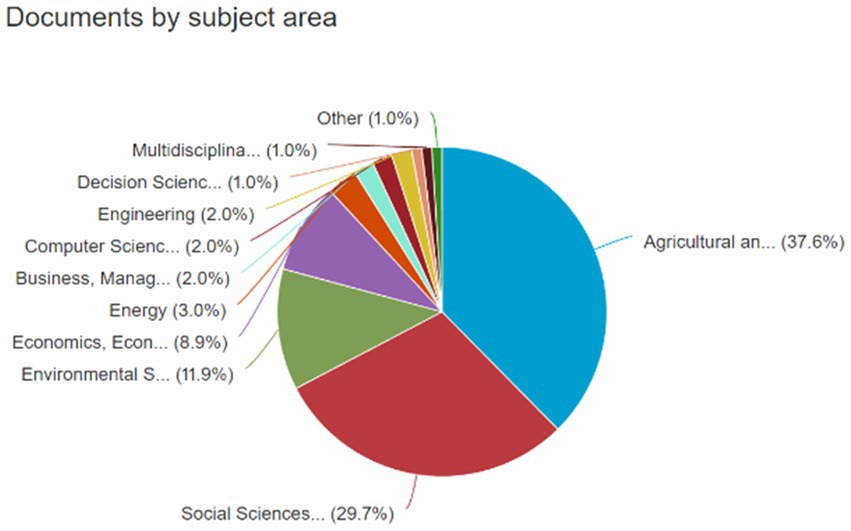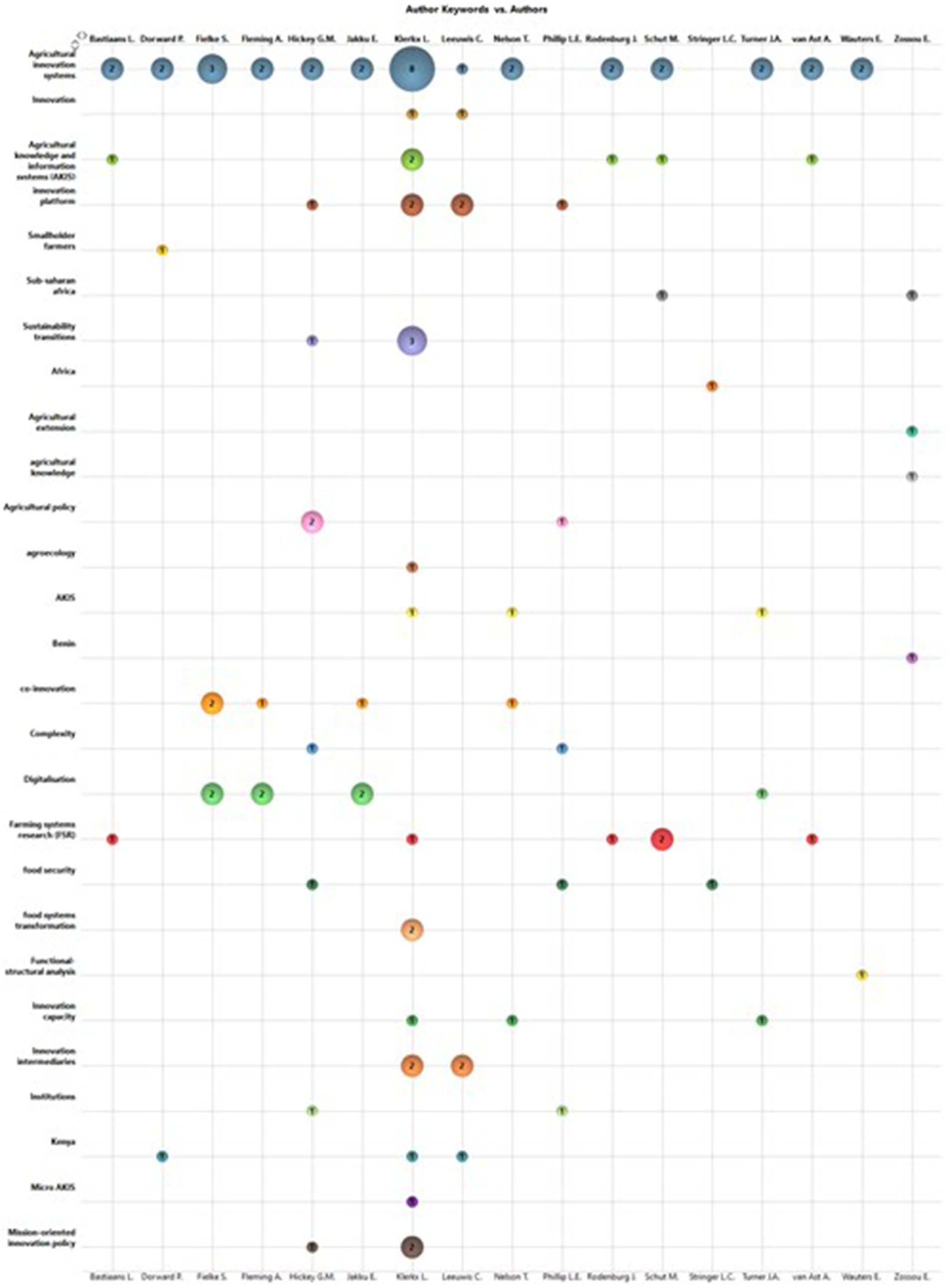Agricultural innovation system: analysis from the subsystems of R&D, training, extension, and sustainability
- 1Faculty of Social Communication-Journalism, School of Social Sciences, Pontifical Bolivarian University, Medellín, Colombia
- 2Faculty of Agroindustrial Engineering, School of Engineering, Pontifical Bolivarian University, Medellín, Colombia
- 3Faculty of Agrarian Sciences and Agroindustry, Universidad Tecnológia de Pereira, Pereira, Colombia
The challenges faced by agricultural innovation systems (A.I.S.) are complex to solve, however, the authors consider that understanding the processes of innovation and development (R&D), sustainability, use of information and communication technologies, training, and outreach, as the focus of discussion in this review, have great potential to close the gaps in the system; as well as exploring strategies, projects and best practices that dynamize the operation of the system. The objective of this article is to review the literature on A.I.S.A. to identify its obstacles, challenges, and solution to close its gaps. The methodology identified the critical factors of system monitoring and defines search suitability to obtain 55 documents. With the results, a qualitative analysis is conducted on the mentioned axes, which is complemented with the text mining software Vantage Point V 15.1 to observe in graphical form the most relevant aspects. Within the conclusions is a constant demand from actors for access to information, and knowledge in the training processes, it is recommended in this regard the additional skills for innovation and participation in concerted practices. As regards the limitations of agricultural innovation processes, it suggests the involvement of cooperatives, technological platforms, and farmers’ organizations as intermediaries relevant to closing gaps. With regard to sustainability, A.I.S. thinking is recommended for an inclusive dialogue among actors and to facilitate sustainability transitions. Finally, to address the socio-technical and ethical challenges of access to technologies and technological transition, it is recommended to design appropriate policies for access to resources and the development of markets that enhance business opportunities and the development of sustainable innovations.
1. Introduction
The agricultural innovation systems (A.I.S.) is composed of farmers and public and private institutions and uses systems thinking to improve innovation in the agricultural sector (Hall et al., 2006) however, the development of R&D processes has been complex due to the difficulty of effectively articulating individuals and institutions (Ortiz et al., 2015; Alcázar Quiñones 2017) to the growing concern for a comprehensive understanding of the actors and to the factors influencing agricultural innovation in local, regional and national settings due to the complexity of such processes as noted by Klerkx et al. (2012) likewise, to the quality of stakeholder interactions and capabilities, to guide policies, articulate demand and foster reflexivity in advancing agricultural innovation (Minh, 2019). In such a direction, the literature recognizes the importance of addressing the AIS comprehensively and systemically, considering a wide variety of factors and actors involved, and promoting innovative solutions to address the challenges of the sector.
Concerning sustainability obstacles to the transition to sustainable water harvesting have been identified and institutional difficulties have been pointed out that impede the legitimization of innovative technologies (Sixt et al., 2018) however, innovative practices have been discovered to address various challenges in agriculture, such as water scarcity, mortality, and livestock theft, through resilience processes as indicated by Amankwah et al. (2012). Concerning the processes of innovation and information and communication technology (ICT) it is valued the contribution of input suppliers in the diffusion of technologies (Hornum and Bolwig, 2021) as well as obstacles to productive reconversion, organizational and commercial modernization, production, and consumption. In addition, flaws and imperfections have been detected in the system that hinders the development of the dairy sector, however, solutions combining institutional and technological interventions have been proposed to overcome these challenges according to Kebebe et al. (2015) also face challenges the creation of new skills, capacities, and local knowledge (Jaramillo et al., 2001). Finally, training processes lack a dialogue between academic and farmer knowledge (Hernández-Pérez, 2019).
Finally, the lack of dialogue between academic knowledge and the farmer in the processes of training agricultural (Hernández-Pérez, 2019) recognizes the importance of the perspective multidisciplinary (Raina, 2003) of gender and the approach A.I.S. (Kingiri, 2013) the research and extension agricultural, as well as the relevance of cooperatives of farmers in the promotion of innovation (Yang et al., 2014).
The objective of the following conceptual framework is to analyze all the elements involved in the complex and dynamic process that influences the performance and operation of the A.I.S.. Therefore, the conceptual framework proposed by Spielman and Birner (2008) is taken as a reference. As observed in Figure 1 this framework is composed of several domains, such as knowledge and education, commercial and business, as well as extension institutions, political channels, and stakeholder platforms.
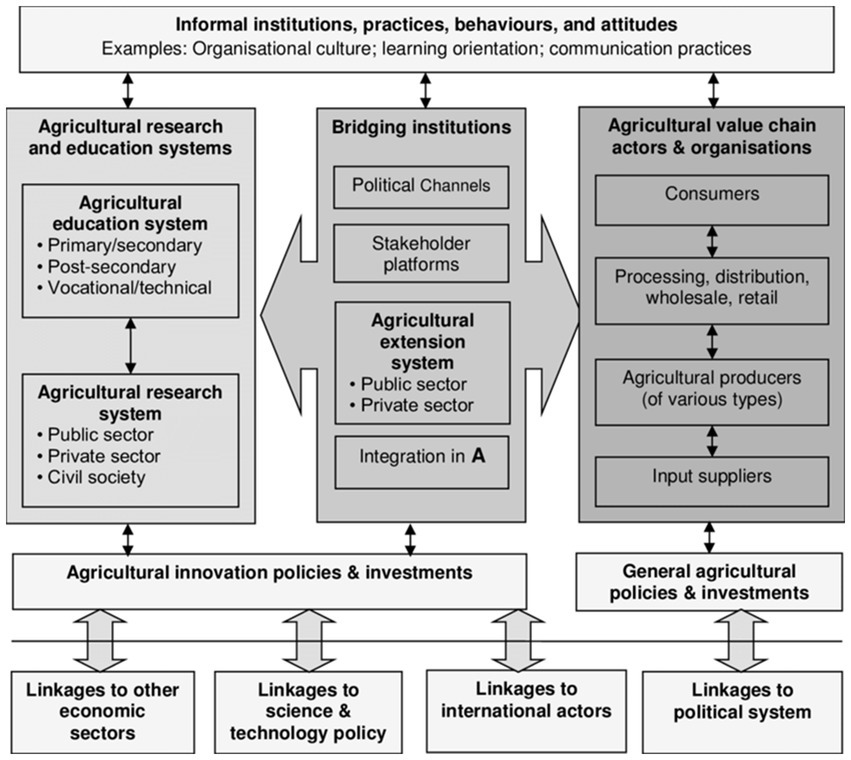
Figure 1. Conceptual Framework A.I.S. (Spielman and Birner, 2008).
Within this framework, farmers as actors become a bridge within these processes, while public policies, informal institutions, behaviors, practices and attitudes, sectors of the economy, STI (Science Technology, and Innovation) policies, international actors, knowledge sources, and markets, as well as the political system, also play a key role in the emergence of innovation.
The following are the different sections contained in this article. The theoretical framework: this section will provide a framework for identifying the key elements of the functioning of the S.I. and its subsystems from a broad viewpoint. Methodology: the technology or academic watch tool will be used for the analysis of the axes of discussion and for the identification of best practices, projects, and strategies that contribute to the resolution of A.I.S. obstacles through the critical watch factors established for this review of the system. Results and conclusions: the findings obtained from the literature reviewed will be presented, as the axes of discussion, also, the relevant strategies, practices, and projects that contribute from their contributions to the improvement of the system.
2. Theoretical framework
The concept of an innovation system (I.S.) has its origins in economics and has evolved as new institutions and processes that contribute to the emergence of innovation have been identified. The systemic approach to I.S. has been addressed by several authors. The first approaches were given by List (1841) and Leontief (1941) who spoke of National Production Systems. Later, Freeman, (1982, 1987), Lundvall (1985, 1988, 1992), Nelson (1993) and Metcalfe (1995) focused on the national level. These authors recognize the importance of collaborative work and interactions to dynamize the diffusion of new technologies, as well as the link between the economic and institutional structure and the contribution of institutions to the performance of innovation processes and provide at the same time the framework for governments to influence innovation processes through the implementation of channels and infrastructure for knowledge transfer.
In summary: according to United Nations Conference on Trade and Development (UNCTAD, 2019) the systemic capacity of the I.S. depends on the actors, the connections, the framework conditions, and the enabling environment, but developing countries have limited systems, while high-income countries focus on advanced technology without achieving sustainable and inclusive growth, and most IS having weak enabling environments.
The I.S. approach has several schools of thought that prove valuable for analyzing and improving the system and fostering innovation in this sector. Its application can serve as for example: evolutionary economics can help to understand how technology and innovation in agriculture evolve and change over time (Nelson and Winter, 1982); institutional economics can be useful in analyzing the role of institutions in the diffusion of agricultural innovation, such as government programs or farmer organizations (Nelson, 1992); new regional economies can allow the study of the interaction between regions in terms of agricultural innovation and economic development (Storper, 1995); the economics of learning can be relevant for understanding how firms and farmers acquire knowledge and skills over time (Lundvall and Johnson, 1994; Foray and Lundvall, 1996); the economics of innovation can be useful for analyzing how agricultural innovations are generated, developed and diffused (Dosi et al., 1988) and network theory can be applied to understand the relationships between different actors in the system and how they influence economic behavior in this area (Hakansson, 1987).
2.1. The National Agricultural Innovation System
The National Agricultural Innovation System (N.A.I.S.) in Colombia is an important contribution to the innovation system because it promotes research, technological development, and innovation in the sector through policies, programs, and projects. This improves the competitiveness of the sector, as well as the quality of life of rural communities and the country’s food security. In addition, the N.A.I.S. involves the participation of various stakeholders, such as universities, companies, government, and interface entities, which contributes to the creation of innovation and collaboration networks for the development of innovative solutions in the agricultural sector. Synthesis: N.A.I.S. is an important component of the innovation system in Colombia, which fosters research, technological development, and innovation in the agricultural sector and promotes collaboration between the different actors involved in the process (Ley 1876 de 2017, n.d.).
2.2. Regional innovation system
Regional innovation systems (R.I.S.) provide a broader and more specific perspective of innovation processes in a given region (Lundvall et al., 2009; Robledo, 2010) because they consider the particularities of that region, such as its history, culture, geography, politics, and economy (Padilla-Pérez et al., 2009). These particularities allow the identification of the strengths and weaknesses of each region and the development of more appropriate and effective innovation strategies and policies (Asheim et al., 2011). In addition, the R.I.S. takes into account the interaction between the different actors and subsystems in a region, which can facilitate the development of networks and collaborations that foster innovation and knowledge transfer (Padilla-Pérez et al., 2009). In short: the R.I.S.’s. provide a more detailed and contextualized view of innovation processes in a region, which can improve their effectiveness and contribute to sustainable development.
2.3. Sectoral system of agricultural innovation
The Sector Innovation System (S.I.S.) is a perspective that complements the National and Regional Innovation Systems approaches by focusing on innovation in a specific sector of the economy. S.I.S. focuses on the actors and dynamics of innovation in a specific sector and seeks to understand how innovations are created, developed, and diffused in that sector. In addition, S.I.S. has a view of the relationships between key industry players, knowledge networks, and institutions that influence innovation. This allows the S.I.S. to have a more specifically detailed review of innovation in a particular sector and can help identify opportunities to improve the competitiveness and productivity of such a sector (Malerba, 2005).
3. Methodology
During this session, different phases were carried out to review the existing literature on A.I.S. is presented. The different stages of the methodology used are summarized in Figure 2.
In phase I, critical surveillance factors and keywords were identified, as shown in Table 1, in addition to the necessary constraints for tracking related studies and the selected analysis period.
In phase 2, several equations were made and finally, the following equation was chosen for the analysis: TITLE-ABS-KEY (“agricultural innovation system*”) AND R&D OR extension OR transfer OR training OR qualification OR sustentab* AND gap*. After this, the results were analyzed using Vantage Point V 15.1 text mining software. This software allowed a graphical representation, as well as the performance of a cluster analysis and co-occurrence matrices.
In phase 3, after applying the previously mentioned equation, 55 documents relevant to the A.I.S. landscape were identified. From these results, an analysis table or matrix was created that included the following aspects: document title, authors, year of publication, countries of origin, and contributions of each subsystem, covering terms such as agricultural extension, training, research and development, sustainability, innovation, and ICT. In addition, other significant aspects were considered, such as strategies, best practices, and projects related to the AIS (see Tables 2–4).
4. Results
In this section, we begin to analyze the results obtained from the Scopus search. Figure 3 shows the documents published by year, to observe the trend of publications over time.
It should be noted that the year 2022 had the highest number of documents published, with a total of 13. It is followed in order of the number of publications by 2019, with seven papers, and in 2020 and 2021, with five papers each. On the other hand, publications in 2007 are scarce.
Figure 4 shows the year of publication according to the source of origin of the documents.
The source of origin of the publications has been limited to those with the highest number of published papers, among which Agricultural Systems stands out with 14 publications, followed by the Journal of Agricultural Education and Extension with 5 publications. Other sources of publications of note include the International Journal of Agricultural Sustainability, Journal of Rural Studies, Innovation and Development, Land Use Policy y Regional Environmental Change, each with 2 publications. In addition, 22 institutions contributed only one document.
Figure 5 shows the number of documents per author or author.
Among the authors with the most papers published, Klerkx with 12, followed by Hickey with 5, Leeuwis, Schut, and Zossou with 3 each, and a group of authors with 2 publications each, such as Bastiaans, Dorward, Fielke, Fleming, Jakku, Nelson, Phillip, Rodenburg, Stringer, Wauters, and Van Ast.
The most outstanding authors in the field of study of A.I.S. include Klerkx who published articles on equity in innovation agriculture and Hickey who has worked on the dissemination of innovations in cooperative agriculture, while. Leeuwis has focused his studies on the development of A.I.S.. Schut has researched the intensification of sustainability of the agricultural systems and Zossou about the tool of support for the making of decisions. Other authors have contributed to related topics such as sustainability, policy, and planning, management of innovation, and participation of farmers.
Then, in Figure 6, document by affiliation.
Among the institutions with the highest number of affiliations are Wageningen University & Research with 16 affiliations, followed by the University of Reading with 4 affiliations and Université McGill, the University of Leeds, and CIRAD with 3 affiliations each. Other institutions with 2 memberships are the Food and Agriculture Organization of the United Nations, la Universiteit Antwerpen, la University of Ghana, AgResearch Ruakura, CSIRO Land and Water, International Livestock Research Institute Nairobi, McGill University, Macdonald Campus, AfricaRice, Instituut voor Landbouw en Visserijonderzoek, L’Institut Agro Montpellier y la Université de Montpellier.
Below, the figure documents by country or territory (see Figures 7–11).
Countries with the highest number of documents are highlighted, including the Netherlands with 16 documents, followed by Kenya and the United Kingdom with 8 documents each, the United States with 7, Canada and France with 5, Australia with 4, and Belgium, Benin, Côte d’Ivoire, Tanzania, and Uganda with 3 each. In addition, there are several countries with 2 documents and some with only 1 document.
In the classification of documents by areas of study, the following results were found: 38 in Agriculture and Biological Sciences; 30 in Social Sciences; 12 in Environmental Sciences; 9 in Economics, Econometrics, and Finance; 3 in Energy; 2 in Business, Management, and Accounting; 2 in Computer Sciences; 2 in Engineering; 1 in Decision Sciences; 1 in Multidisciplinary Sciences; and 1 in Veterinary Science.
It is interesting to note that most of the papers focus on the areas of Agricultural and Biological Sciences and Social Sciences, with 38 and 30 publications, respectively. This suggests that research in this field is largely focused on issues related to agriculture and rural development, as well as on social issues related to development and innovation in the agricultural sector. In addition, there is a significant number of papers in the area of Environmental Sciences, suggesting a growing concern for sustainability and environmental impact in agriculture. On the other hand, it is interesting to note that energy, economics, and computer science are also research areas in which some papers have been published on agricultural development.
The following figure shows a cluster analysis that visualizes the relationships and co-authorships among authors in the field of study. Collaboration among actors is fundamental for the production of knowledge about the A.I.S. as can be seen in the figure showing a cluster analysis.
This analysis shows that most of the authors have collaborated in the creation of only one article. However, some authors such as Hickey, Phillip, Rodenburg, Bastianns, Schut, and Klerkx have contributed two papers each. In addition, a cluster can be identified with three publications by authors Leeuwis and Klerkx, indicating a closer collaboration between them in their research.
The figure following and above shows the most frequent words used in the publications analyzed.
The word cloud highlights key terms such as A.I.S., technology innovation platforms, responsible innovation, co-innovation, innovation capabilities, innovation-oriented policy, sustainability, the African continent, functional and structural analysis, institutions, intermediaries, food, extension, rural development, participation, among others. It also highlights the importance of knowledge management, stakeholder collaboration, and governance in the field of study. It is also possible to identify words related to the African context, where most of the analyzed research has been carried out. Overall, the word cloud provides an overview of the most relevant topics and can help identify key areas for future research.
5. Analysis of results
The results are then analyzed. We will begin by observing the trends in each of the periods and present the results obtained in the different discussion axes. Finally, strategies, projects, and best practices found during the literature review will be identified.
5.1. Publications within the period 1998–2007
During the first period of analysis between 1998 and 2007, the importance of agricultural research and management as challenging issues for sustainable development in Latin America is highlighted and the need for good financing and coordination among institutional actors to address these issues effectively is emphasized (Echeverría, 1988). It also highlights the importance of a multidisciplinary perspective in agricultural research and extension that impacts advances in agricultural science and technology. It is also recognized that development depends to a large extent on the institutional learning capacity of scientists and policymakers (Raina, 2003). In West Africa, it has been identified that multi-stakeholder learning coalitions at the local level can be an effective way to address institutional problems (Nederlof et al., 2007).
5.2. Publications within the 2012–2013 period
During the period 1998–2007, the importance of intermediaries in closing cognitive, information, managerial, or systems gaps in the AIS was highlighted (Koutsouris, 2012). The generation and dissemination of agricultural information are crucial for gap closure in Uganda, but its access depends largely on the quality of relationships and the level of trust of sources (Sseguya et al., 2012).
In addition, agricultural productivity and sustainability depend on innovation in A.I.S. governance and cooperation between countries, public and private sectors, and regulation that fosters innovation in G20 members (Moreddu and Van Tongeren, 2013). Intermediaries and network facilitators are important in catalyzing innovative co-production processes in the dairy sector in the Netherlands and Australia (Klerkx and Nettle, 2013). The co-evolution of innovation is a dynamic process that can be solved by using intermediaries and platforms adaptable to the unpredictability of innovation (Kilelu et al., 2013). Finally, it is concluded that it is important to include the gender perspective within agricultural innovations, including integrated activities such as agriculture, extension, and services making a call for greater empowerment of women in the generation of gender-equitable innovations within the framework of the S.I. (Kingiri, 2013).
5.3. Publications within the 2014–2015 period
During 2014–2015, the role of intermediaries in innovation processes within farming systems is recognized. Coffee farmer cooperatives are relevant actors in the promotion and diffusion of innovation because of their ability to connect with other actors such as extension agencies, research institutes, and supermarkets can improve productivity and sustainability (Yang et al., 2014). Crop protection innovation processes require a systemic and integrated approach that addresses technical, institutional, and policy dimensions (Schut et al., 2014).
To improve the capacity of smallholder farmers in southeast Asia and Sub-Saharan Africa, it is proposed to match external supply with actual demand for capacities through strengthening South–South collaboration, improving institutional capacities, and responding to the needs of smallholder farmers within national agriculture (Aerni et al., 2015). The interactions of the components of an A.I.S. are necessary to determine the technical efficiency of agricultural production in low- and middle-income countries, in such a direction it is indicated that cellular subscriptions and the number of scientific and technical journal articles could improve technical efficiency in agricultural production in these countries (Mekonnen et al., 2015). The factors affecting the innovation potential of smallholder households in four CARICOM small island developing states (St. Lucia, St. Kitts and Nevis, Trinidad and Tobago, and Guyana) are related to the systemic lack of access to finance, markets, and knowledge networks; to overcome these problems, more decentralized governance approaches capable of establishing stronger relationships between actors and institutions that improve knowledge flows and support regional rural development and food and nutrition security objectives are proposed (Lowitt et al., 2015). Effective generation and transfer of innovations in India necessitate improving the linkages between technology generation, technology diffusion, technology users, and support mechanisms, and forming a networking system among stakeholders leading to a dynamic innovation system. Proposed in such a sense, the concept of the Livestock Innovation System emphasizes that innovations come from multiple stakeholders (Chander and Rathod, 2015).
5.4. Publications within the period 2016–2017
During 2016–2017 it was argued that the lack of cohesion among actors in the A.I.S. is responsible for the limited development and diffusion of appropriate innovations in agricultural production in sub-Saharan Africa. Intermediation, understood as information, knowledge, and financing, can address this gap. It is recommended that intermediaries be integrated into agricultural innovation systems to facilitate access to resources and collaboration among key actors (Adejuwon, 2016). The Agricultural Innovation System approach to understanding the relationships between farmers, researchers, extensionists, and input and service providers, allows the identification of constraints and levels of intervention to design long-term innovations. The articulation of local actors is necessary for the design of appropriate and sustainable innovations according to the needs of the territory (Schut et al., 2016). Focusing on resilience in the context of food security and nutrition, they identify that resilience is affected by social, institutional, and governance contexts, which can be influenced by sound food and nutrition policies (Pelletier et al., 2016). Social networks are important in the diffusion of innovations, according to a study conducted in agricultural cooperatives in Senegal. Highly connected actors in leadership positions are key to controlling innovation, so it is important to foster connectivity and leadership in the cooperative network (Reed and Hickey, 2016).
Reflective monitors (R.M) are vital to the success of co-innovation projects in the primary sector, according to an analysis in New Zealand. Their role is to lead and facilitate the innovation process and they are essential for the generation of new ideas and critical thinking skills (Fielke et al., 2017). The theory of change is needed in agricultural research to plan and evaluate alternative routes in the evaluation of interventions. A linear view of the problems hinders the ability to address the complexity within aquatic agricultural systems in Zambia and the Philippines, thus it is recommended to design more effective and sustainable interventions that consider the complex interactions within agricultural systems (Douthwaite and Hoffecker, 2017). An analytical framework for assessing innovation capabilities at different levels of interaction in New Zealand projects. The framework includes an assessment of historical and current capabilities, identification of adaptive capabilities, and the strategic ambidexterity needed to overcome project stakeholder constraints and achieve success. The importance of addressing both positive and negative pathways of project implementation is emphasized (Turner et al., 2017).
5.5. Publications within the period 2018–2019
During the publications for the period 2018–2019, some perspectives and research on innovation and sustainability in agriculture are presented. The importance of investing in research to improve the compatibility and labor productivity of agroforestry systems in Flanders, and how to link private and social actors in niche markets for the production of agroecological products, and strengthen the dialog between influential groups to overcome technical, financial, legal, organizational and social challenges (Borremans et al., 2018). The integration of innovation ecosystem and agricultural innovation systems perspectives into sustainable agricultural innovation research and practice to address agricultural sustainability transitions to more sustainable systems (Pigford et al., 2018). La theory of change to assess the impact of agricultural communication and extension programs in promoting agricultural sustainability, using the Shamba Shape Up television program as an example (Clarkson et al., 2018). The analysis of Sectoral Innovation systems and the need for these to be consumer and market-oriented, increase interactions outside the boundaries of the conventional system, include the consumer perspective and social changes and determine the role of gender in innovation in agri-food systems (Dallimer et al., 2018).
The importance of improving access to agricultural information for farmers in Kenya, emphasizes the need for simple practices and subsidies for the adoption of sustainable practices such as agroforestry (Spendrup and Fernqvist, 2019). The identification of inequality in access to agricultural information for women in Pakistan and the need for training programs (Lamontagne-Godwin et al., 2019). The regional and structural dimensions can block the functioning of a regional AIS and the need for an adaptive approach to address an effective transformation of the Regional Innovation Agricultura system (Minh, 2019). The importance of adapting farmers’ innovation support networks to their needs and social skills, and how different network configurations can achieve ambidexterity (Cofré-Bravo et al., 2019). The identification of the social, economic, and environmental impacts of the UK fresh produce sector (Menary et al., 2019). The analysis of the adoption of agricultural information systems (A.I.S.) in the rice industry using the theory of planned behavior, identifying the key cognitive drivers behind their use, as well as the barriers that may impede their adoption. The results show that ease of application, improved food safety and enhanced ability to innovate are the key cognitive drivers, while lack of knowledge/skills, adequate funding, and incentives are potential barriers (Kamara et al., 2019). The policy implications of digital technology development in shrimp aquaculture in Australia. It is based on social impact theory and exploratory interviews with stakeholders in the shrimp aquaculture value chain. The study concludes that there is uncertainty around the policy implications of digital technologies in the agricultural industry and proposes that stakeholders engage in a debate to mitigate risks and transition into the future. In particular, it is suggested that forums would allow for greater negotiation and awareness, which would contribute to risk mitigation and transition pathways into the future (Fielke et al., 2017).
5.6. Publications within the 2020–2021 period
During the 2020 period publications find that in Nicaragua, the agroecological transition faces systemic barriers such as lack of guidance, insufficient resources, and lack of market development (Schiller et al., 2020). In Burkina Faso, the impact evaluation of the Participatory Sorghum Improvement program shows how research can strengthen individual and collective capacities needed to innovate and test new agricultural technologies (Vom Brocke et al., 2020). In West African countries, factors influencing farmers to acquire agricultural knowledge and adopt technology include household size, training, access to formal and informal knowledge sources, socioeconomic status of the community, and farmers’ reliance on technology adoption (Zossou et al., 2021). Multi-stakeholder platforms (M.S.P.) as collaborative networks of stakeholders that achieve different levels of innovation according to the proposed objectives and activities. However, four limitations are identified in the existing literature on the M.S.P., including disciplinary silo thinking, a limited focus on politics and informal institutions, and a lack of attention to power dynamics (Barzola Iza et al., 2020). The mission-oriented A.I.S. (MAIS) approach allows for analysis of how food systems evolve at different geographic scales and how key actors promote food systems transformation. In addition, the MAIS provides information on barriers and opportunities in food systems. This approach is considered novel for analysis and can be useful for both researchers and decision-makers in the field of agriculture and food (Klerkx and Begemann, 2020).
RiceAdvice is a decision support tool for improving rice productivity and profitability in smallholder rice farming in sub-Saharan Africa. For expansion, improvements in access to financial services and input supplies, identification and testing of business models, and outreach approaches that include women service providers are needed (Zossou et al., 2021). The innovation story methodology helps stakeholders in the pineapple value chain in Africa to document and co-learn key innovations in the sector. This methodology identifies the challenges and conditions that facilitate the adoption of innovations and the objectives of the pineapple value chain and agricultural change (Ankrah, 2022).
Innovation platforms (IPs) are important for advancing cocoa production, processing, and marketing in Ghana. To strengthen it, it is necessary to encourage the participation of farmers’ groups, researchers, extensionists, politicians, and the private sector. Thematic and social network analysis provides insight into stakeholder roles and linkages and provides options for strengthening the cocoa innovation platform (Onumah et al., 2021). Farmer’s organizations (FOs) in Burkina Faso act as knowledge and innovation brokers to stimulate the adoption of agroecological innovations by farmers (Iyabano et al., 2022). The importance of tertiary agricultural education and participation in the African Innovation System (AIS) is to transform agricultural research capacity in African countries and improve food security and reduce poverty (Tizikara et al., 2021). The use of possibility theory and the S.I. perspective. to explore how agricultural innovation occurs in the context of the Climate-Smart Agriculture Program (C.S.A.P.) in Tanzania, and how farmers should be at the center of sustainable and effective change (Smith et al., 2021).
5.7. Publications year 2022
During the year 2022 publications analyze the importance of collaboration and technical and financial capacity in the Conservation Agriculture Innovation System in Malawi. It is proposed to strengthen understanding of AIS approaches among stakeholders, build stronger partnerships in research and development, and strengthen collaborative advisory mechanisms to facilitate knowledge sharing, resource mobilization, and joint program implementation (Chinseu et al., 2022). The importance of the multilevel perspective within agricultural innovation processes and the adoption of responsible innovation requires a comprehensive understanding of all interacting components at all societal scales to achieve sustainable transitions (de Boon et al., 2022). The role of innovation platforms (I.P.) in sustainable agricultural innovation in Tigray, Ethiopia. It is concluded that these platforms contribute to stronger relationships that facilitate the co-creation of innovative solutions, but research and improved practices are needed to maximize their effectiveness (Seifu et al., 2022). The analysis of limitations and opportunities in R&D, adoption processes, and dissemination of forage technologies in Colombia from the perspective of A.I.S.. It is concluded that the lack of connection between institutions and the weak intensity of relationships prevent the convergence of interests that generate vicious circles that hinder the adoption of technology. It is proposed to work more collaboratively among institutions and to develop more effective ways of adopting and scaling up technologies (Enciso et al., 2022).
A study of 50 H2020 projects in agriculture and forestry found that there is a need to improve project performance through generic policy or project management interventions at the macro or microsystem level of innovation. They also identified multilevel system failures and mitigating factors (Cronin et al., 2022). Analysis of seven stakeholder networks involved in agroecological innovation in Laos highlighted the importance of creating and nurturing spaces in which stakeholders are empowered to think and act collectively in complexity to drive agroecological transition (Castella et al., 2022).
The farm advisory studies in Benin found four factors limiting farmers’ access to this service, such as a focus on large farms, excessively specialized advice, a limited number of advisors, and a monitoring and evaluation system that is poorly oriented to quality (Aplogan et al., 2022). Australia’s Digiscape Future Science Platform program uses the responsible innovation framework (R.I) to address the challenges of responsible R&D practice in digital agriculture. They also consider the interactions between technology developers and users for the successful and responsible development of agricultural technologies (Jakku et al., 2022).
The factors influencing rural farmers’ behavioral intentions to recycle human excreta in agriculture draw on psychosocial theories, technology adoption theories, and the new ecological paradigm demonstrating that social acceptance was driven by conscientiousness, religiosity, income, source of income, and environmental dispositions, but perceived behavioral control represents a potential barrier to human excreta reuse. The study recommends the demographic, cultural, sociological, and economic integration of dissemination strategies for circular bioeconomy approaches in the context of agricultural innovation systems (Gwara et al., 2022).
6. Discussion
Discussion on the A.I.S. was held where the axes applied in the literature review, such as training, extension, innovation and development, sustainability, innovation, and I.C.T. Important aspects such as strategies, best practices, and important projects are also mentioned. These aspects are considered in the opinion of the authors as relevant for any study on the AIS and closing gaps in it.
6.1. Process of training and education
The following are several studies that address the processes of training and education in A.I.S. and agriculture, from different perspectives and geographical contexts. The analysis of the Shamba Shape Up television program in Kenya and its impact on innovation processes in small-scale agriculture. The program uses an “edutainment” format to educate and entertain farmers, and the researchers find that this approach has been effective in influencing farmer behavior and encouraging innovation in agriculture. The article suggests that using entertainment formats to disseminate knowledge can be an effective strategy for promoting positive change in agriculture and other sectors (Clarkson et al., 2018).
The implementation of agricultural advisory services in sub-Saharan Africa proposes an approach for implementing agricultural advisory services in sub-Saharan Africa, based on practical training adapted to the context and available resources, and the dissemination of technical information through demonstrations, farm visits, and the exchange of experiences. In addition, the advisor focuses on supporting one or two reference producers with whom he/she maintains a close relationship (Aplogan et al., 2022).
The analysis of the systemic problems and the blocking mechanisms of an Innovation Agricultural Regional system in Vietnam proposes that when system actors lack capabilities, spaces should be created for capacity building, which can be achieved through the provision of education and training programs, the development of technological platforms and the promotion of pilot projects. These strategies can help improve the capacity of actors to participate in the innovation system and generate positive changes in the innovation system (Minh, 2019).
The population, food system, and environmental challenges facing African agricultural colleges can be addressed through research and innovation as key tools to fill resource gaps and provide sustainable solutions. The transformation agenda they propose is demand-driven, strategic, collaborative, and adaptive. The goal is to leverage the talents of faculty, students, and alumni and facilitate collaboration with farmers, consumers, communities, businesses, and governments to solve practical problems in agriculture and food systems (Tizikara et al., 2021).
The review of the organizational framework and strategies for implementing agricultural advice in sub-Saharan Africa to better adapt it to the socioeconomic and institutional realities identified several problems, such as the lack of mutual trust between farmers and advisors, the lack of sufficient agricultural advisors to serve the multitude of farmers, the low qualifications of some farmers, the lack of effective tools and methods, and an inefficient monitoring and evaluation system. The authors propose solutions to address these problems, such as revising the organizational framework, training agricultural advisors, promoting mutual trust, and improving the monitoring and evaluation system (Aplogan et al., 2022).
The diversity of microAKIS (Local Agri-Food Knowledge Systems) leads to different types of innovation, both technological and non-technological. In addition, the active participation of farmers in advisory processes and decision-making to adopt innovations energizes the role of advisory services in innovation. The study is based on the application of an analytical framework focused on European farmers called MicroAKIS (Madureira et al., 2022).
The application of the A.I.S. approach in agricultural research and extension used the framework of the theory of planned behavior to explain that the socioeconomic characteristics of research and extension professionals influence their intention and beliefs regarding the use of the A.I.S. approach. The majority of respondents were male in the age range of 31 to 40 years old and had bachelor’s and master’s degree level education. Results showed that women and younger respondents had a higher intention to use the A.I.S. approach than researchers (Kamara et al., 2019).
The comprehension of expansionists’ perceptions of gendered access to information and analysis of the role of these perceptions in the development of gender-sensitive initiatives can contribute to transformative change in gender perspectives. Researchers suggest that a greater understanding of individual perceptions of extension workers and farmers is needed to develop gender-sensitive initiatives that are specific and targeted (Lamontagne-Godwin et al., 2019).
The studies reviewed highlight the importance of the public agricultural research and extension system in India in promoting the generation and transfer of innovations. The authors propose improving training and access to technical information, creating spaces for capacity building, and the adaptation of agricultural advisory programs. It also highlights the importance of engaging farmers and understanding the socioeconomic characteristics and beliefs of research and extension professionals and suggests that microAKIS diversity influences the adoption of technological and non-technological innovation (Chander and Rathod, 2015).
6.2. Innovation and development (R&D)
The R&D processes find the importance of the important role of innovation platforms (IP) in coordinating and stimulating the joint evolution of innovation. It is indicated that policies that support innovation platforms through funding, planning, and governance mechanisms that enable continuous adaptation to emerging problems are key (Kilelu et al., 2013).
The importance of including all the multiple actors in the value chain in the generation of knowledge and harnessing it reflexively to facilitate the adoption of agricultural innovations. Some agricultural innovations that emerged from farmers themselves are mentioned for their contribution to the value chain (Ankrah, 2022).
The existence of differences in the roles and positions of actors in the cocoa innovation system. It is indicated that the role of government in providing policy support structures is important for the proper functioning of the I.S. of cocoa. The study emphasizes the poor performance of the A.I.S. is the result of structural constraints, such as inadequate knowledge, lack of physical and financial infrastructure, limited capacities, poor stakeholder accountability and interactions, lack of intermediaries, and institutional failures (Minh, 2019).
The relevant role of networks and interactions for innovation within the agri-food sector. It is indicated that the research focuses on the existing boundaries of the system, i.e., agents related to the conventional structure of the sector (Spendrup and Fernqvist, 2019).
Logic models and complexity-aware theory of change (ToC) provide a starting point for testing a set of hypotheses embedded in the common linear impact adoption pathway. It is indicated that it is important to model the impact pathways, their various causal connections, and hypotheses to describe reality more accurately (Douthwaite and Hoffecker, 2017).
Knowledge and innovation in formal cooperatives diffuse mainly through vertical linkages led by key players with the power to control the flow of knowledge, which can result in variation in the adoption of innovative practices. In addition, individual-level social networks vary and affect the ability to access and share innovative knowledge (Reed and Hickey, 2016).
6.3. Sustainability
The use of SLM practices in Kenya suggests prioritizing simple practices used by smallholder farmers to improve soil and increase yields. It is recommended that policymakers consider a combination of economic and financial instruments, institutional and capacity-building actions, and changes in the legal, political, social, and technical context to foster sustainable land management practices (Dallimer et al., 2018).
The use of the concept of A.I.S. as a more suitable approach to the multifunctionality of farming systems and to support the development of cross-border innovation niches designed for sustainability. According to the authors, this approach needs to be more explicit about power dynamics in innovation platforms or communities, including both human and non-human change agents throughout the innovation ecosystem, and be more aware of boundary crossings. The goal is to realize collective and integrated innovation toward sustainability (Pigford et al., 2018).
Researchers analyze the limitations and opportunities of A.I.S. for Sustainable Intensification Sin the highlands of central Africa. The approach provides them with a holistic view of the constraints faced by different stakeholder groups, the dimensions and causes of these constraints, and the levels of intervention, timelines, and types of innovations needed to overcome them. It is concluded that to overcome these problems, it is necessary to integrate multi-stakeholder structures and processes and set a research, policy, and development agenda for sustainable resource intensification (Schut et al., 2016).
6.4. Innovation and ICT
A review of the literature on innovation and ICT addresses the subject of innovation in agriculture and its challenges. They discuss the socio-ethical challenges associated with digital agriculture and the Digiscape Future Science Platform program in Australia. The opportunities and challenges related to the implementation of responsible innovation in digital agrotechnology will discuss the Digiscape Future Science Platform, a program that seeks to facilitate the digital transformation of Australia’s agricultural industries and land-based sectors. The authors find significant socio-ethical challenges associated with digital agriculture (Jakku et al., 2022).
Farmers with the use of RiceAdvice saw an increase in rice yield and production income and a reduction in fertilizer inputs. The positive impacts were also received by the human and social capital of the beneficiaries (farmers and service providers). This justifies the need for further effort in scaling up RiceAdvice as an innovative agricultural tool in northern Nigeria (Zossou et al., 2021).
A distinctive organizational feature of multi-stakeholder platforms (MSPs) relative to other novel organizational forms in emerging economies involves the presence of a virtual and/or physical interface encompassing heterogeneous stakeholders. Second, concerning their impact pathways toward farmer innovation, MSPs tend to achieve different outcomes and levels of innovation according to their organizational objectives and activities (Barzola Iza et al., 2020).
The T.I.S. approach helps to analyze the transition to agroecology holistically. Based on a case study in Nicaragua, central mechanisms hindering the transition were identified, such as policy misalignments, inadequate resource mobilization, and insufficient market development. Although these barriers hinder the diffusion of agroecology, TIS analysis allows identifying specific factors that enhance these barriers (Schiller et al., 2020).
The following section presents the various strategies, projects, and practices that have been found in the literature review on the AIS, which can be used to close the system’s gaps and solve its obstacles.
6.5. Agricultural extension
The authors propose adapting agricultural advice to socioeconomic and institutional realities, improving mutual trust between partners, increasing the number of agricultural advisors, and improving farmer training to implement a participatory and inclusive approach to agricultural extension. Emphasis is placed on the need for operational tools and methods, appropriate working standards, and a monitoring and evaluation system geared toward the effectiveness of the councils. The article highlights that the low rate of producer support is a major problem in agricultural extension (Aplogan et al., 2022).
The MicroAKIS framework, an analytical framework for understanding the role of counseling in innovation from the perspective of farmers depends on a limited number of types of suppliers of advice, even in the environments of counseling pluralists. The researchers found that the plurality of advice is expressed more among farmers than by an individual farmer. The data empirically helped to understand the heterogeneity of the European advisory scape, which is related to the infrastructure of AKIS and the dynamics of the area of innovation (Madureira et al., 2022).
The discussion of the authors is focused on understanding the perceptions of the extensionists. About the access to information according to gender in Pakistan, as well as in analyzing the differences between the perceptions of the individual workers of extension and the farmers to develop initiatives sensitive to gender that can contribute to a transformative change. The authors argue that it is necessary to consider the perspectives of both groups to achieve a meaningful change in the policy institute of gender in Pakistan. Also, it seeks to frame these findings in the current situation of current inequality of gender in the country (Lamontagne-Godwin et al., 2019).
The authors analyze the relationship between the livestock innovation system (LIS) and the agricultural innovation agricultural (AIS), emphasizing the importance of the system’s public research and extension of the AIS. in the generation and transfer of innovations in countries such as India. It defends the implementation of LIS in the country and proposes strategies for improving the productivity of livestock. It describes the challenges faced by the system of research and extension. Livestock in India and lessons are taken from developed countries (Chander and Rathod, 2015).
The study on the intention of the extensionists when using the approach AIS through the theory of behavior planned. The results suggest the characteristics socioeconomic of the respondents. Influence on their intention and beliefs concerning the use of SIA (Kamara et al., 2019).
6.6. Highlighted strategies
The identification of strategies is essential for the success of any organization or system in the agricultural sector and allows for a more coherent and unifying approach to decisions, action programs, and resource allocation (Castellanos Domínguez, 2009).
6.7. Best practices
FAO (Food and Agriculture Organization of the United Nations (UN) 2014) refers to good agricultural practices as the set of principles applicable, both in field cultivation and subsequent industrial production, resulting in safe food and consumer products while respecting environmental, economic, and social sustainability (FAO). The following table identifies the best practices found in the literature reviews.
6.8. Relevant projects
The projects in the A.I.S. are important because it is possible to demonstrate that the strategies and practices implemented are effective and can generate positive results in the agricultural sector. The following table lists some of the relevant projects.
7. Conclusion
This section presents the conclusions from the review of 55 research papers conducted between 1983 and 2022. The conclusions take into account the analysis by periods and the discussion axes proposed are related to best practices, projects, and strategies highlighted so that these can be used to close the gaps in the AIS.
7.1. Conclusions by a period of analysis
7.1.1. Period of analysis 1998–2007
The publications during this period evidence outdated institutional structures, lack of funding, and also, the need for greater interactions of the various actors that drive the learning of the system. Equally, greater interactions between natural and social scientists, extensionists, farming communities, and policymakers, among other stakeholders. There is concern about the lack of research on the subject, particularly in Latin America.
7.1.2. Period 2012–2013
Studies on A.I.S. challenges related to environmental aspects, new technologies, and human resources prevail. Again, the need for greater participation among actors in the transformation of the A.I.S. appears. The potential of innovation processes for productivity growth and innovation promotion in Latin America takes into account cooperation between countries, public-private partnerships, and the creation of laws and standards.
7.1.3. Period 2014–2015
There are important conclusions about the brokering role of knowledge and the innovation fulfilled by the cooperatives. It is highlighted by research coverage of three regions, southeast Asia, sub-Saharan Africa, and central America, the findings found a mismatch of all the regions in the external supply of capacity building. There is a need to improve agricultural production through investments that consider efficiency. For the effective transfer of the innovations, it is stated a need to enhance the linkages between the technology generation (research), the dissemination of technology (extension), the users of technology (farmers), and the support mechanisms (input supply, market credit, etc.) through the configuration of networks among stakeholders. The systemic lack of access to financing also appears as a problem to be solved.
7.1.4. Period 2016–2017
Within the limitations of all the processes of diffusion of sustainable intensification innovations may be due to, a lack of cohesion among actors within innovation systems and constraints of an economic and institutional nature (political, markets, capabilities, financial resources, and interaction), and poor collaboration between the stakeholders. Unequal access to information is a problem that affects women involved in agricultural activities worldwide.
7.1.5. Period 2020–2021
Research addresses the barriers hindering agroecological transition evidenced by debilities in capabilities and resources. The knowledge of farmers is influenced by factors such as household size, training, access to formal and informal knowledge sources, and the socioeconomic status of the community. The support that can be provided by the mission-oriented agricultural innovation system (MAIS) is necessary for understanding agricultural innovation systems at different geographic scales and for achieving the transformation of food systems thus.
7.1.6. The year 2022
These studies are oriented to the analysis of key players within the AIS, the strengthening of approaches and advice processes, and the establishment of stronger alliances in R&D. Within the complexity of the AIS, the key components are identified, such as the macro and immediate context, the governance systems, the innovative and adaptive capacity of the actors, the psychosocial factors and the innovation process itself is. Analytical integration of micro- and macro-level innovation system perspectives is necessary to fully understand the mechanisms underlying the functioning and process of co-innovation within multi-stakeholder H2020 projects. It is suggested that the use of information and communication tools in agricultural extensions could stimulate community members to learn and thus reduce their dependence on group leaders. Training of varying duration according to the context and available means is recommended, and the dissemination of technical information be accompanied by demonstration sessions, farm visits, exchange of experiences, etc. On the other hand, the formulation of an agenda for the transformation of capabilities for innovation through the creation of postgraduate programs.
7.2. Conclusions by main lines of discussion
The conclusions obtained from the discussion topics addressed are presented below. Firstly, it highlights the importance of implementing capacity-building and training processes to address the challenges facing agriculture and innovation in different contexts. To this end, strategies and approaches that have proven to be effective in various studies should be used, and emphasis should be placed on considering the specificities of the territory for the proper functioning of the initiatives. Various actions are proposed to improve farmer training and education, such as the implementation of education and training programs, the development of technological platforms, and the promotion of pilot projects.
To address the challenges of R&D in the agri-food sector, strategies and approaches have been identified such as the use of innovation platforms for the coordination and stimulation of the joint evolution of innovation, as well as the use of logic models and complexity-aware theory of change (ToC) to describe reality more accurately. These initiatives can significantly improve collaboration among the different actors involved in R&D and ultimately drive innovation in the agri-food sector. Government plays a crucial role in providing policy support structures to foster this collaboration.
Third, strategies and approaches to meet the challenge of sustainability in the agri-food sector are discussed. It also emphasizes the need to combine economic instruments and changes in the legal, political, social, and technical contexts to achieve a significant impact. The use of the Agricultural Innovation Ecosystem approach is suggested to foster innovation and sustainability in agriculture. Ultimately, it is concluded that addressing sustainability issues in the agri-food sector requires a comprehensive and collaborative approach that involves multiple stakeholders and sets a clear agenda for research, policy, and development.
Fourth, it highlights the importance of innovation and information and communication technologies (ICTs) in agriculture, and how they can be used to achieve sustainable land management practices, improve the efficiency of agricultural tools, and address the socio-ethical challenges associated with digital agriculture.
Finally, the agricultural extension requires adapting agricultural advice to local realities and promoting inclusiveness and equity in decision-making and implementation of agricultural policies and practices, as well as analyzing the heterogeneity of the advisory landscape in Europe and proposing strategies to improve livestock productivity in countries such as India and considering the perspectives of both groups in the specific context of Pakistan.
7.3. Conclusions strategies, practices, and projects
The discussion around agricultural innovation recognizes the importance of adopting a systemic and integrated approach, as well as the inclusion of a gender perspective to foster innovation and rural development. It is important to recognize that the diversity of actor networks, institutional change, and institutional alliances are key elements in the A.I.S.. Sustainability and accountability are crucial aspects of agricultural innovation, and challenges at the macro and micro levels of the agricultural innovation system need to be addressed to achieve project success. In summary, agricultural innovation should be understood as a systemic and integrated process that promotes sustainability and inclusion, addressing challenges at multiple levels of the system.
Data availability statement
The original contributions presented in the study are included in the article/Supplementary material, further inquiries can be directed to the corresponding author.
Author contributions
JZ and GO: conceptualization, search equation, methodology, and conclusions. LG and DA: theoretical framework, methodology, results, discussion, and conclusions. LS and JQ: background, discussion, software management, and validation. All authors contributed to the article and approved the submitted version.
Acknowledgments
Ministry of Agriculture and Rural Development of Colombia and the Faculty of Agricultural and Agroindustrial Sciences of the Universidad Tecnológica de Pereira (UTP).
Conflict of interest
The authors declare that the research was conducted in the absence of any commercial or financial relationships that could be construed as a potential conflict of interest.
Publisher’s note
All claims expressed in this article are solely those of the authors and do not necessarily represent those of their affiliated organizations, or those of the publisher, the editors and the reviewers. Any product that may be evaluated in this article, or claim that may be made by its manufacturer, is not guaranteed or endorsed by the publisher.
Supplementary material
The Supplementary material for this article can be found online at: https://www.frontiersin.org/articles/10.3389/fsufs.2023.1176366/full#supplementary-material
References
Adejuwon, O. O. (2016). Bridging gaps in innovation systems for small-scale agricultural activities in sub-Saharan Africa: brokers wanted innovation and development. Innov. Dev. 6, 175–193. doi: 10.1080/2157930X.2016.1195089
Aerni, P., Nichterlein, K., Rudgard, S., and Sonnino, A. (2015). Making agricultural innovation systems (AIS) work for development in tropical countries. Sustainability 7, 831–850. doi: 10.3390/su7010831
Alcázar Quiñones, A. T. (2017). Metodología" Arreglos y Sistemas Productivos Innovativos Locales" en municipios cubanos. Retos de la Dirección 11, 198–212. Available at: http://scielo.sld.cu/scielo.php?script=sci_arttext&pid=S2306-91552017000200013&lng=es&tlng=pt
Amankwah, K., Klerkx, L., Oosting, S. J., Sakyi-Dawson, O., van der Zijpp, A. J., and Millar, D. (2012). Diagnosing constraints to market participation of small ruminant producers in northern Ghana: an innovation systems analysis. NJAS-Wagen. J. Life Sci. 60-63, 37–47. doi: 10.1016/j.njas.2012.06.002
Ankrah, D. A. (2022). Ghana’s pineapple innovation history: an account from stakeholders in Nsawam Adoagyiri municipal assembly. Afr. J. Sci. Technol. Innov. Dev. 14, 1916–1932. To link to this article:. doi: 10.1080/20421338.2021.1988414
Aplogan, A., Zossou, E., and Zoundji, G. C. (2022). Entre abstraction et réalité dans la mise en œuvre du conseil agricole en Afrique subsaharienne: leçons apprises des expériences du département de l’Atlantique au Bénin. Eur. J. Dev. Res. 34, 1118–1143. doi: 10.1057/s41287-021-00424-x
Asheim, B. T., Smith, H. L., and Oughton, C. (2011). Regional innovation systems: theory, empirics, and policy. Reg. Stud. 45, 875–891. doi: 10.1080/00343404.2011.596701
Barzola Iza, C. L., Dentoni, D., and Omta, O. S. W. F. (2020). The influence of multi-stakeholder platforms on farmers' innovation and rural development in emerging economies: a systematic literature review J. Agribusiness Dev. Emerg. Econ. 10, págs. 13–39. doi: 10.1108/JADEE-12-2018-0182
Borremans, L., Marchand, F., Visser, M., and Wauters, E. (2018). Nurturing agroforestry systems in Flanders: analysis from an agricultural innovation systems perspective. Agric. Syst. 162, 205–219. doi: 10.1016/j.agsy.2018.01.004
Castella, J.-C., Lestrelin, G., Phimmasone, S., Tran Quoc, H., and Lienhard, P. (2022). The role of actor networks in enabling agroecological innovation: lessons from Laos. Sustainability 14:3550. doi: 10.3390/su14063550
Castellanos Domínguez, O. F. (2009). Retos y Nuevos Enfoques en la Gestión de la Tecnología y el Conocimiento. Ing. Investig. 29:141.
Chander, M., and Rathod, P. K. (2015). Livestock innovation system: reinventing public research and extension system in India. Ind. J. Anim. Sci. 85, 1155–1163.
Chinseu, E. L., Dougill, A. J., and Stringer, L. C. (2022). Strengthening conservation agriculture innovation systems in sub-Saharan Africa: lessons from a stakeholder analysis. Int. J. Agric. Sustain. 20, 17–30. doi: 10.1016/j.agsy.2018.04.007
Clarkson, G., Garforth, C., Dorward, P., Mose, G., Barahona, C., Areal, F., et al. (2018). Can the TV makeover format of edutainment lead to widespread changes in farmer behavior and influence innovation systems? Shamba shapes up in Kenya. Land Use Policy 76, 338–351. doi: 10.1016/j.landusepol.2018.05.011
Cofré-Bravo, G., Klerkx, L., and Engler, A. (2019). Combinations of bonding, bridging, and linking social capital for farm innovation: How farmers configure different support networks. Journal of Rural Studies 69:53–64.
Cronin, E., Fieldsend, A., Rogge, E., and Block, T. (2022). Multi-actor horizon 2020 projects in agriculture, forestry, and related sectors: a multi-level innovation system framework (MINOS) for identifying multi-level system failures. Agric. Syst. 196:103349. doi: 10.1016/j.agsy.2021.103349
Dallimer, M., Stringer, L. C., Orchard, S. E., Osano, P., Njoroge, G., Wen, C., et al. (2018). Who uses sustainable land management practices and what are the costs and benefits? Insights from Kenya. Land Degrad. Dev. 29, 2822–2835. doi: 10.1002/ldr.3001
de Boon, A., Sandström, C., and Rose, D. C. (2022). Governing agricultural innovation: a comprehensive framework to underpin sustainable transitions. J. Rural. Stud. 89, 407–422. doi: 10.1016/j.jrurstud.2021.07.019
Dosi, G., Freeman, C., Nelson, R.R., Silverberg, G., and Soete, L. (Edits.). (1988). Technical Change and Economic Theory. London and New York: Pinter Publishers.
Douthwaite, B., and Hoffecker, E. (2017). Towards a complexity-aware theory of change for participatory research programs working within agricultural innovation systems. Agric. Syst. 155, 88–102. doi: 10.1016/j.agsy.2017.04.002
Echeverría, R. G. (1988). Agricultural research policy issues in Latin America: an overview. World Dev. 26 1998, 1103–1111. doi: 10.1016/S0305-750X(98)00036-9
Enciso, K., Triana, N., Díaz, M., and Burkart, S. (2022). On (dis) connections and transformations: the role of the agricultural innovation system in the adoption of improved forages in Colombia. Front. Sustain. Food Syst. 5:535. doi: 10.3389/fsufs.2021.741057
Fielke, S. J., Nelson, T., Blackett, P., Bewsell, D., Bayne, K., Park, N., et al. (2017). Hitting the bull’s-eye: the role of a reflexive monitor in New Zealand agricultural innovation systems. In 12th European International Farming Systems Association (IFSA) Symposium, Social and Technological Transformation of Farming Systems: Diverging and Converging Pathways, 12–15 July 2016, Newport, Shropshire, UK: Harper Adams University, 1–13). International Farming Systems Association (IFSA) Europe
Food and Agriculture Organization of the United Nations (UN). The state of food and agriculture (SOFA): innovation in family farming ; FAO: Rome, Italy, (2014). Available at: http://www.fao.org/3/a-i4040e.pdf
Foray, D., and Lundvall, B.-A. (1996). The knowledge-based economy: from the economics of knowledge to the learning economy. O. Documents Paris: Employment and Growth in the Knowledge-based Economy.
Freeman, C. (1982). Technological infrastructure and international competitiveness. Draft document presented to the OECD Ad Hoc Group on Science, Technology and Competitiveness.
Freeman, C. (1987). Technology policy and economic performance: lessons from Japan, London, Pinter Publishers.
Gwara, S., Wale, E., and Odindo, A. (2022). Behavioral intentions of rural farmers to recycle human excreta in agriculture. Scientific reports 12(1), 5890.
Hakansson, H. (1987). Industrial technology development: a network approach. J. Prod. Innov. Manag. 4, 163–165.
Hall, A., Janssen, W., Pehu, E., and Rajalahti, R.. (2006). World Bank. 2006. Enhancing agricultural innovation: how to go beyond the strengthening of research systems. World Bank.
Hernández-Pérez, J. L. (2019). Sistema de innovación agrícola como estrategia de competitividad de los productores sonorenses en el contexto del TLCAN. Rev. Aliment. Contemp. Desar. Reg. 29. doi: 10.24836/es.v29i54.828
Hornum, S. T., and Bolwig, S. (2021). Functional analysis of the role of input suppliers in an agricultural innovation system: the case of small-scale irrigation in Kenya. Agric. Syst. 193:103219. doi: 10.1016/j.agsy.2021.103219
Iyabano, A., Klerkx, L., Faure, G., and Toillier, A. (2022). Farmers’ organizations as innovation intermediaries for agroecological innovations in Burkina Faso. Int. J. Agric. Sustain. 20, 857–873. doi: 10.1080/14735903.2021.2002089
Jakku, E., Fielke, S., Fleming, A., and Stitzlein, C. (2022). Reflecting on opportunities and challenges regarding implementation of responsible digital agri-technology innovation. Sociol. Rural. 62, 363–388. doi: 10.1111/soru.12366
Jaramillo, C. (2001). Evaluación de la seguridad alimentaria con una visión integral. Proyecto piloto: vereda Los Medios, municipio de Sonsón (Antioquia). Cuadernos de desarrollo rural 46.
Kamara, L. I., Dorward, P., Lalani, B., and Wauters, E. (2019). Unpacking the drivers behind the use of the agricultural innovation systems (AIS) approach: the case of rice research and extension professionals in Sierra Leone. Agric. Syst. 176:102673. doi: 10.1016/j.agsy.2019.102673
Kebebe, E., Duncan, A. J., Klerkx, L., de Boer, I. J., and Oosting, S. J. (2015). Understanding socio-economic and policy constraints to dairy development in Ethiopia: a coupled functional-structural innovation systems analysis. Agric. Syst. 141, 69–78. doi: 10.1016/j.agsy.2015.09.007
Kilelu, C. W., Klerkx, L., and Leeuwis, C. (2013). Unraveling the role of innovation platforms in supporting co-evolution of innovation: contributions and tensions in a smallholder dairy development program. Agric. Syst. 118, 65–77. doi: 10.1016/j.agsy.2013.03.003
Kingiri, A. N. (2013). A review of innovation systems framework as a tool for gendering agricultural innovations: exploring gender learning and system empowerment. J. Agric. Educ. Ext. 19, 521–541. doi: 10.1080/1389224X.2013.817346
Klerkx, L., and Begemann, S. (2020). Supporting food systems transformation: the what, why, who, where and how of mission-oriented agricultural innovation systems. Agric. Syst. 184:102901. doi: 10.1016/j.agsy.2020.102901
Klerkx, L., and Nettle, R. (2013). Achievements and challenges of innovation co-production support initiatives in the Australian and Dutch dairy sectors: a comparative study. Food Policy 40, 74–89. doi: 10.1016/j.foodpol.2013.02.004
Klerkx, L., Van Mierlo, B., and Leeuwis, C. (2012). “Evolution of systems approaches to agricultural innovation: concepts, analysis, and interventions” in Farming systems research into the 21st century: The new dynamic. eds. I. Darnhofer, D. Gibbon, and B. Dedieu, Springer 457–483.
Koutsouris, A. (2012). Facilitating agricultural innovation systems: a critical realist approach. Stud. Agric. Econ. 114, 64–70. doi: 10.7896/j.1210
Lamontagne-Godwin, J., Cardey, S., Williams, F. E., Dorward, P. T., Aslam, N., and Almas, M. (2019). Identifying gender-responsive approaches in rural advisory services that contribute to the institutionalization of gender in Pakistan. J. Agric. Educ. Ext. 25, 267–288. doi: 10.1080/1389224X.2019.1604392
Leontief, W. W. (1941). The structure of the American economy, 1919–1929: An empirical application of equilibrium analysis, Harvard University Press.
Ley 1876 de 2017. (n.d.). Por medio de la cual se crea el Sistema Nacional de Innovación Agropecuaria y se dictan otras disposiciones. 29 de diciembre de 2017.
Lowitt, K., Hickey, G. M., Saint Ville, A., Raeburn, K., Thompson-Colón, T., Laszlo, S., et al. (2015). Factors affecting the innovation potential of smallholder farmers in the Caribbean community. Reg. Environ. Chang. 15, 1367–1377. doi: 10.1007/s10113-015-0805-2
Lundvall, B. (1992). "National system of innovation: towards a theory of innovation and interactive learning ", Londres, Pinter
Lundvall, B. A., and Johnson, B. (1994). Sistemas nacionales de innovación y aprendizaje institucional. Comer. Ext. 44, 695–704.
Lundvall, B.-Å. (1985). Product Innovation and User-Producer Interaction. Aalborg: Aalborg University Press.
Lundvall, B.-Å. (1988). Innovation as an interactive process: from user-producer interaction to the national innovation system. En G. Lundvall.
Lundvall, B.-Å., Vang, J., Joseph, K. J., and Chaminade, C. (2009). Innovation system research and developing countries. En B.-Å. Lundvall, K. J. Joseph, C. Chaminade, J. Vang, E. Elgar, B.-Å. Lundvall, K. J. Joseph, C. Chaminade, & J. Vang (Edits.), Handbook of Innovation Systems and Developing Countries (págs. 1-32). Cheltenham - Northampton: Edward Elgar Publishing.
Madureira, L., Labarthe, P., Marques, C. S., and Santos, G. (2022). Exploring microAKIS: farmer-centric evidence on the role of advice in agricultural innovation in Europe. J. Agric. Educ. Ext. 28, 549–575. doi: 10.1080/1389224X.2022.2123838
Malerba, F. (2005). Sectoral system of innovation: a framework for linking innovation to the knowledge base, structure, and dynamics of sectors. Econ. Innov. New Technol. 14, 63–82. doi: 10.1080/1043859042000228688
Mekonnen, D. K., Spielman, D. J., Fonsah, E. G., and Dorfman, J. H. (2015). Innovation systems and technical efficiency in developing-country agriculture. Agric. Econ. 46, 689–702. doi: 10.1111/agec.12164
Menary, J., Collier, R., and Seers, K. (2019). Innovation in the UK fresh produce sector: identifying systemic problems and the move towards systemic facilitation. Agric. Syst. 176:102675. doi: 10.1016/j.agsy.2019.102675
Metcalfe, J. S. (1995). Technology systems and technology policy in an evolutionary framework. Camb. J. Econ. 19, 25–46. doi: 10.1093/oxfordjournals.cje.a035307
Minh, T. T. (2019). Unpacking the systemic problems and blocking mechanisms of a regional agricultural innovation system: an integrated regional-functional-structural analysis. Agric. Syst. 173, 268–280. doi: 10.1016/j.agsy.2019.03.009
Moreddu, C., and Van Tongeren, F. (2013). Improving agricultural productivity sustainably at a global level: the role of agricultural innovation policies. EuroChoices 12, 8–14. doi: 10.1111/1746-692X.12013
Nederlof, E. S., Röling, N., and Van Huis, A. (2007). Pathway for agricultural science impact in West Africa: lessons from the convergence of sciences program. Int. J. Agric. Sustain. 5, 247–264. doi: 10.1080/14735903.2007.9684825
Nelson, R. R. (1992). National Innovation Systems: A retrospective on Study. Industrial and Corporate Change 1(2): 347.
Nelson, R. R. (Ed.) (1993). National innovation systems: a comparative analysis, Oxford University Press.
Nelson, R. R., and Winter, S. G. (1982). The Schumpeterian tradeoff revisited. Am. Econ. Rev. 72, 114–132.
Onumah, J. A., Asante, F. A., and Osei, R. D. (2021). Actor roles and linkages in the agricultural innovation system: options for establishing a cocoa innovation platform in Ghana. Innov. Dev. 1-22, 1–22. doi: 10.1080/2157930X.2021.1965752
Ortiz, R., Miranda, M. L. O., and Roselló, T. (2015). Sistema de Innovación Agropecuario Local (SIAL) por un enfoque participativo en la gestión del desarrollo. Documentos de trabajo del proyecto de innovación Agropecuario Local (PIAL)
Padilla-Pérez, R., Vang, J., and Chaminade, C. (2009). “Regional innovation systems in developing countries: integrating micro and meso-level capabilities” in Handbook of innovation systems and developing countries. eds. B.-Å. En, K. J. Lundvall, and C. Joseph. Edward Elgar Publishing
Pelletier, B., Hickey, G. M., Bothi, K. L., and Mude, A. (2016). Linking rural livelihood resilience and food security: an international challenge. Food Secur. 8, 469–476. doi: 10.1007/s12571-016-0576-8
Pigford, A. A. E., Hickey, G. M., and Klerkx, L. (2018). Beyond agricultural innovation systems? Exploring an agricultural innovation ecosystems approach for niche design and development in sustainability transitions. Agric. Syst. 164, 116–121. doi: 10.1016/j.agsy.2018.04.007
Raina, R. S. (2003). Disciplinas, instituciones y organizaciones: evaluaciones de impacto en contexto. Sistem. Agríc. 78, 185–211. doi: 10.1016/S0308-521X(03)00126-4
Reed, G., and Hickey, G. M. (2016). Contrasting innovation networks in smallholder agricultural producer cooperatives: insights from the Niayes region of Senegal. J. Co-op. Organ. Manag. 4, 97–107. doi: 10.1016/j.jcom.2016.09.001
Robledo, J. (2010). Introducción a la Gestión Tecnológica. Medellín: Universidad Nacional de Colombia Sede Medellín.
Schiller, K. J., Klerkx, L., Poortvliet, P. M., and Godek, W. (2020). Exploring barriers to agroecological transition in Nicaragua: a technological innovation systems approach. Agroecol. Sustain. Food Syst. 44, 88–132. doi: 10.1080/21683565.2019.1602097
Schut, M., Rodenburg, J., Klerkx, L., van Ast, A., and Bastiaans, L. (2014). Systems approach innovation in crop protection. A systematic literature review. Crop Prot. 56, 98–108. doi: 10.1016/j.cropro.2013.11.017
Schut, M., van Asten, P., Okafor, C., Hicintuka, C., Mapatano, S., Nabahungu, N. L., et al. (2016). Sustainable intensification of agricultural systems in the central African highlands: the need for institutional innovation. Agric. Syst. 145, 165–176. doi: 10.1016/j.agsy.2016.03.005
Seifu, M., van Paassen, A., Klerkx, L., and Leeuwis, C. (2022). A state-initiated multi-stakeholder platform as an instrument to build agricultural innovation system capacity: a case study from Ethiopia. Innov. Dev. 1-22, 1–22. doi: 10.1080/2157930X.2022.2064959
Sixt, G. N., Klerkx, L., and Griffin, T. S. (2018). Transitions in water harvesting practices in Jordan’s rained agricultural systems: systemic problems and blocking mechanisms in an emerging technological innovation system. Environ. Sci. Policy 84, 235–249. doi: 10.1016/j.envsci.2017.08.010
Smith, H. E., Sallu, S. M., Whitfield, S., Gaworek-Michalczenia, M. F., Recha, J. W., Sayula, G. J., et al. (2021). Innovation systems and affordances in climate-smart agriculture. J. Rural. Stud. 87, 199–212. doi: 10.1016/j.jrurstud.2021.09.001
Spendrup, S., and Fernqvist, F. (2019). Innovation in Agri-food systems–a systematic mapping of the literature. Int. J. Food Syst. Dyn. 10, 402–427. doi: 10.18461/ijfsd.v10i5.28
Spielman, D. J., and Birner, R. (2008). How innovative is your agriculture? Using innovation indicators and benchmarks to strengthen national agricultural innovation systems, 55 Available at: http://siteresources.worldbank.org/INTA.
Sseguya, H., Mazur, R., Abbott, E., and Matsiko, F. (2012). Information and communication for rural innovation and development: context, quality, and priorities in Southeast Uganda. J. Agric. Educ. Ext. 18, 55–70. doi: 10.1080/1389224X.2012.638783
Storper, M. (1995). Regional technology coalitions are an essential dimension of national technology policy. Res. Policy 24, 895–911. doi: 10.1016/0048-7333(94)00810-8
Tizikara, C., Nampala, P., Nielson, D., Beintema, N., Okori, P., and Lynam, J. (2021). “Transformative research and innovation capacity in tertiary agricultural education in Africa” in Transforming tertiary agricultural education in Africa (Wallingford UK: CABI), 135–155.
Turner, J. A., Klerkx, L., White, T., Nelson, T., Everett-Hincks, J., Mackay, A., et al. (2017). Unpacking systemic innovation capacity as strategic ambidexterity: how projects dynamically configure capabilities for agricultural innovation. Land Use Policy 68, 503–523. doi: 10.1016/j.landusepol.2017.07.054
UNCTAD (2019). A framework for science, technology, and innovation policy reviews harnessing innovation for sustainable development science, technology, and innovation policy review. Geneva. United Nations.
Vom Brocke, K., Kondombo, C. P., Guillet, M., Kaboré, R., Sidibé, A., Temple, L., et al. (2020). Impact of participatory sorghum breeding in Burkina Faso. Agric. Syst. 180:102775. doi: 10.1016/j.agsy.2019.102775
Yang, H., Klerkx, L., and Leeuwis, C. (2014). Roles and limitations of farmer cooperatives as innovation intermediaries: Findings from China. Agricultural Systems, 127, 115–125. doi: 10.1016/j.agsy.2014.02.005
Keywords: agricultural innovation system, innovation system, innovation and development, extension, technology of the information and communication, sustainability
Citation: Gutiérrez Cano LF, Zartha Sossa JW, Orozco Mendoza GL, Suárez Guzmán LM, Agudelo Tapasco DA and Quintero Saavedra JI (2023) Agricultural innovation system: analysis from the subsystems of R&D, training, extension, and sustainability. Front. Sustain. Food Syst. 7:1176366. doi: 10.3389/fsufs.2023.1176366
Edited by:
Marzia Ingrassia, Università degli Studi di Palermo, ItalyReviewed by:
Justice Gameli Djokoto, Central University (Ghana), GhanaOscar Hernán López Montoya, Tolima University, Colombia
Julio Gonzalez, University of Santiago, Chile
Copyright © 2023 Gutiérrez Cano, Zartha Sossa, Orozco Mendoza, Suárez Guzmán, Agudelo Tapasco and Quintero Saavedra. This is an open-access article distributed under the terms of the Creative Commons Attribution License (CC BY). The use, distribution or reproduction in other forums is permitted, provided the original author(s) and the copyright owner(s) are credited and that the original publication in this journal is cited, in accordance with accepted academic practice. No use, distribution or reproduction is permitted which does not comply with these terms.
*Correspondence: Luis Fernando Gutiérrez Cano, luisfe.gutierrez@upb.edu.co
 Luis Fernando Gutiérrez Cano
Luis Fernando Gutiérrez Cano Jhon Wilder Zartha Sossa
Jhon Wilder Zartha Sossa Gina Lía Orozco Mendoza2
Gina Lía Orozco Mendoza2 